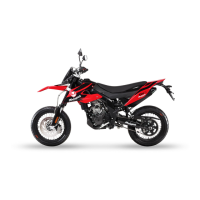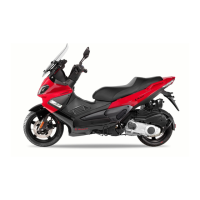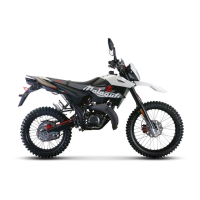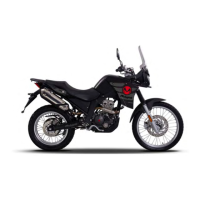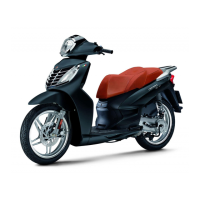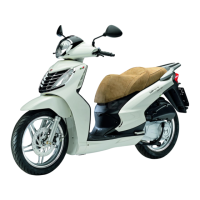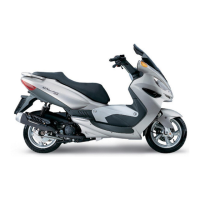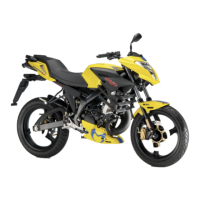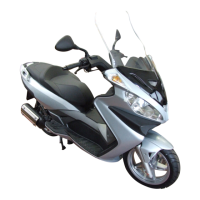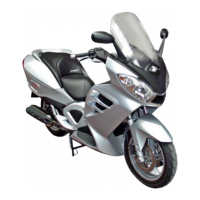Do you have a question about the Malaguti RST125 2018 and is the answer not in the manual?
Explains important signals for vehicle use and safety.
Highlights dangers of not following prescriptions for personal safety.
Describes correct behavior to avoid damaging the environment.
Warns about potential vehicle damage and warranty invalidation.
Provides a numbered list of controls and their corresponding functions.
Explains the various displays on the instrument panel.
Details the total distance traveled by the vehicle.
Describes the TRIP meter data and reset function.
Shows maximum vehicle speed and coolant temperature.
Operation of the headlight switch for low and high beams.
Function of the horn button.
How to operate turn signals for left and right.
Explains engine stop, neutral, and starting positions.
Instructions for locking and unlocking the handlebar.
How to start the engine using the starter switch.
Proper use and care of the front brake lever.
How to operate the throttle lever.
How to engage and disengage the clutch.
Information on the keys provided for ignition and fuel tank.
Description of the fuel tank cover and its latch.
Step-by-step guide to open the fuel tank cover.
Step-by-step guide to close the fuel tank cover.
Where to find the chassis number on the steering head.
Where to find the engine number on the crankcase.
Checks for fuel, oil, battery, chain, brakes, and tires.
Fuel tank capacity and recommended fuel type.
Critical actions before and during refueling to ensure safety.
Guidelines for proper refueling and securing the tank cap.
Importance of good tyre condition and recommended replacement intervals.
Advice on maintaining correct tyre pressure for performance and safety.
Steps for removing and installing the seat.
Recommendations for riding during the first 1000 km for optimal engine performance.
Detailed steps for starting the engine.
Warning against starting the engine in poorly ventilated areas due to toxic exhaust.
Proper procedure for shutting down the engine.
Steps to take if the engine is flooded.
Troubleshooting steps if the engine fails to start after refueling.
Warnings about engine performance when cold or during downhill riding.
Emphasizes driving within abilities and avoiding hazardous substances.
Recommendations for safe daily riding, including helmet use and road conditions.
Advice on managing potholes and wet roads for safe braking.
Advice on proper braking, especially in adverse conditions.
Warning about the danger of driving with an improperly secured helmet.
Strict warnings against altering vehicle features due to legal and safety reasons.
Rules for safely placing and securing additional loads on the vehicle.
How to shift gears, including clutch and throttle operation.
Information on required tools and specifications for engine oil.
Specifies engine oil capacity, type, and viscosity.
Warning about using non-specified engine oil affecting performance and longevity.
Step-by-step instructions for checking the engine oil level.
Warning against adding oil with different characteristics.
Instructions for refilling the engine oil to the correct level.
Detailed steps for draining oil, cleaning the filter, and refilling.
Steps for draining oil and removing the oil filter and spring.
Instructions for cleaning the filter with solvent and drying it.
Checking filter, rubber ring, and stopper ring for damage before reassembly.
Refilling oil, tightening components, and checking the level after running the engine.
Warning to avoid contact with hot engine oil to prevent burns.
Information on environmental hazards of used oil and proper disposal.
Warning about potential skin cancer risks from prolonged contact with used oil.
Step-by-step guide for removing the spark plug.
Details on installing the spark plug and checking the electrode gap.
Guidance on spark plug replacement intervals and warnings against incorrect parts.
Step-by-step guide for cleaning the air filter foam element.
Notes on the importance of cleaning the air filter for engine performance.
Instructions for inspecting the air filter for damage and replacing if necessary.
Recommendation for frequent cleaning, especially in dusty conditions.
Emphasizes the critical role of the air filter for engine life and performance.
Instructions for checking the front brake fluid level.
Guidelines for refilling the brake fluid using the specified type.
Warnings about brake fluid contact and immediate cleaning.
Ensuring no leaks and checking hoses for damage.
Prohibition against altering factory brake pump settings.
Caution about brake fluid's corrosivity to vehicle parts.
Explains how moisture affects brake fluid performance.
Recommendation to replace brake fluid every 2 years.
Steps for removing the seat and installing the battery.
Guidance on battery charging frequency and handling precautions.
Warning about maximum charging rate to prevent battery damage.
Instructions for replacing the battery with one of equal capacity and voltage.
Guidelines for battery maintenance during extended periods of non-use.
Steps before replacing a fuse, including finding the cause of failure.
Caution against using incorrect materials or higher amperage fuses.
Procedure for checking drive chain sag and condition.
Guidance on lubricating the drive chain, including frequency and product application.
Warning against installing a new chain on worn sprockets.
Procedure for lubricating the drive chain, including frequency and product application.
Procedure for replacing low and high beam headlight bulbs.
Details on replacing position, brake, and turn signal lights.
Preparing the vehicle and environment for correct headlight aiming.
Aligning the headlight beam with a marked horizontal line.
Instructions on checking brake pad thickness and replacement intervals.
Explanation that brake disc and pad wear compensate automatically.
Steps for adjusting the clutch lever free play.
Troubleshooting clutch engagement problems and adjusting the timing bolt.
Steps for cleaning, fuel management, and chassis support.
Procedure for engine preparation, including spark plug removal and oil filling.
Guidance on battery maintenance during storage.
Soften dirt and mud, then clean with sponge and soap mixture.
How to rinse the vehicle and dry it with a chamois leather.
Warnings about water pollution, high-pressure jets, and washing in sunlight.
Diagnoses for ignition, air filter, and spark plug issues.
Addresses rough running, cable connections, and mixture problems.
Troubleshooting for high fuel consumption.
Using original parts ensures quality and maintains warranty.
Details on cylinder, bore, stroke, displacement, and compression ratio.
Information on ignition, cooling, lubrication, and fuel system.
Key engine components like EFI valve, spark plug, clutch, and transmission.
Details on the number of gears and secondary transmission.
Information on starter, ignition, battery, and lighting systems.
Description of chassis type and front/rear suspension.
Details on front and rear hydraulic disc brake specifications.
Information on tyre sizes and fuel tank capacity.
| Torque (Nm) | 10.5 Nm |
|---|---|
| Fuel System | Electronic Fuel Injection |
| Front Suspension | Telescopic fork |
| Rear Suspension | Monoshock |
| Fuel System Type | Electronic Fuel Injection |
| Front Suspension Type | Telescopic fork |
| Rear Suspension Type | Monoshock |
| Front Brake Type | Disc |
| Rear Brake Type | Disc |
| Engine Type | Single cylinder, 4-stroke |
| Torque | 10.5 Nm |
| Brakes (Front) | Disc |
| Brakes (Rear) | Disc |
| Cooling | Liquid-cooled |
| Cooling System | Liquid |
